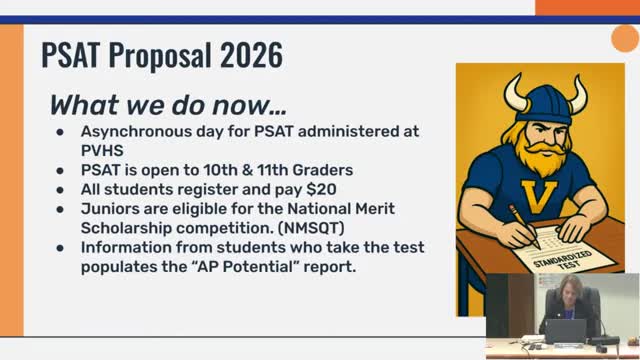Perkiomen Valley officials back offering PSAT to 10th graders, propose district-paid, opt-out model
October 17, 2025 | Perkiomen Valley SD, School Districts, Pennsylvania
This article was created by AI summarizing key points discussed. AI makes mistakes, so for full details and context, please refer to the video of the full meeting. Please report any errors so we can fix them. Report an error »

Zach Fuller, lead principal at Perkiomen Valley High School, told the Perkiomen Valley School District Education Committee that the high school administered the PSAT on Oct. 8 and recommended the district make the test free for 10th graders and optional for juniors.
“The PSAT…is the gateway for juniors to earn National Merit Scholarship consideration,” Fuller said. He described the College Board’s AP-potential report — produced from PSAT results — as a “useful” data point the district could use to identify students who might succeed in Advanced Placement courses.
Fuller proposed keeping the fall day at the high school in which juniors take the PSAT and many non-test-taking students have asynchronous work at home, and adding district-funded registrations for 10th graders so the AP-potential report would cover a wider cohort. Fuller said the test itself costs about $18 plus “administrative fees of a couple bucks” and suggested a rough maximum district cost of about $8,000 to cover the change if uptake increased.
Board members pressed for details about whether the test would be mandatory, how uptake among current 10th graders compares to those already in AP courses and which PSAT product would be administered. Dr. Ford asked whether the district would require participation; Fuller said he would not “force every 10th grader” to take the PSAT and preferred a passive opt-out registration model. Dr. Wesson and Dr. Weston expressed concerns about how AP-potential results might be used — for example, whether students who want AP courses could be discouraged by a low AP-potential score — and Fuller said the report should be one data point among others and not the only route to AP enrollment.
Committee members asked administration to return with more precise counts of which 10th graders already take AP courses and with cost estimates if the committee moves forward. Fuller said he would provide an anonymized sample of the AP-potential report to show how it would be shared with families.
The committee agreed to “move this forward” for further work and review; the discussion indicated administrators should prepare implementation details for a date referenced in the discussion (an October/November timeline was mentioned).
Administration will next report back with exact participation counts, a refined cost estimate, and a proposed communication plan explaining the opt-out process and how AP-potential would be shared with students and families.
“The PSAT…is the gateway for juniors to earn National Merit Scholarship consideration,” Fuller said. He described the College Board’s AP-potential report — produced from PSAT results — as a “useful” data point the district could use to identify students who might succeed in Advanced Placement courses.
Fuller proposed keeping the fall day at the high school in which juniors take the PSAT and many non-test-taking students have asynchronous work at home, and adding district-funded registrations for 10th graders so the AP-potential report would cover a wider cohort. Fuller said the test itself costs about $18 plus “administrative fees of a couple bucks” and suggested a rough maximum district cost of about $8,000 to cover the change if uptake increased.
Board members pressed for details about whether the test would be mandatory, how uptake among current 10th graders compares to those already in AP courses and which PSAT product would be administered. Dr. Ford asked whether the district would require participation; Fuller said he would not “force every 10th grader” to take the PSAT and preferred a passive opt-out registration model. Dr. Wesson and Dr. Weston expressed concerns about how AP-potential results might be used — for example, whether students who want AP courses could be discouraged by a low AP-potential score — and Fuller said the report should be one data point among others and not the only route to AP enrollment.
Committee members asked administration to return with more precise counts of which 10th graders already take AP courses and with cost estimates if the committee moves forward. Fuller said he would provide an anonymized sample of the AP-potential report to show how it would be shared with families.
The committee agreed to “move this forward” for further work and review; the discussion indicated administrators should prepare implementation details for a date referenced in the discussion (an October/November timeline was mentioned).
Administration will next report back with exact participation counts, a refined cost estimate, and a proposed communication plan explaining the opt-out process and how AP-potential would be shared with students and families.
View full meeting
This article is based on a recent meeting—watch the full video and explore the complete transcript for deeper insights into the discussion.
View full meeting